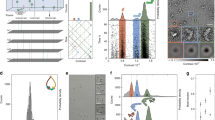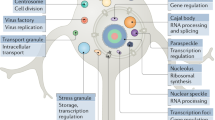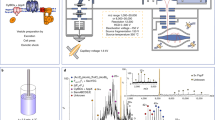Abstract
Membrane-less organelles assemble through liquid–liquid phase separation (LLPS) of partially disordered proteins into highly specialized microenvironments. Currently, it is challenging to obtain a clear understanding of the relationship between the structure and function of phase-separated protein assemblies, owing to their size, dynamics and heterogeneity. In this Perspective, we discuss recent advances in mass spectrometry (MS) that offer several promising approaches for the study of protein LLPS. We survey MS tools that have provided valuable insights into other insoluble protein systems, such as amyloids, and describe how they can also be applied to study proteins that undergo LLPS. On the basis of these recent advances, we propose to integrate MS into the experimental workflow for LLPS studies. We identify specific challenges and future opportunities for the analysis of protein condensate structure and function by MS.
This is a preview of subscription content, access via your institution
Access options
Access Nature and 54 other Nature Portfolio journals
Get Nature+, our best-value online-access subscription
$29.99 / 30 days
cancel any time
Subscribe to this journal
Receive 12 print issues and online access
$259.00 per year
only $21.58 per issue
Buy this article
- Purchase on Springer Link
- Instant access to full article PDF
Prices may be subject to local taxes which are calculated during checkout



Similar content being viewed by others
Data availability
All data are available from the corresponding authors upon reasonable request.
References
Banani, S. F., Lee, H. O., Hyman, A. A. & Rosen, M. K. Biomolecular condensates: Organizers of cellular biochemistry. Nat. Rev. Mol. Cell Biol. 18, 285–298 (2017).
Brangwynne, C. P. et al. Germline P granules are liquid droplets that localize by controlled dissolution/condensation. Science 324, 1729–1732 (2009).
Hnisz, D., Shrinivas, K., Young, R. A., Chakraborty, A. K. & Sharp, P. A. A phase separation model for transcriptional control. Cell 169, 13–23 (2017).
Lafontaine, D. L. J., Riback, J. A., Bascetin, R. & Brangwynne, C. P. The nucleolus as a multiphase liquid condensate. Nat. Rev. Mol. Cell Biol. 22, 165–182 (2021).
Wu, H. & Fuxreiter, M. The structure and dynamics of higher-order assemblies: amyloids, signalosomes, and granules. Cell 165, 1055–1066 (2016).
Bremer, A. et al. Deciphering how naturally occurring sequence features impact the phase behaviours of disordered prion-like domains. Nat. Chem. 14, 196–207 (2022).
Wang, J. et al. A molecular grammar governing the driving forces for phase separation of prion-like RNA binding proteins. Cell 174, 688–699 (2018).
Hardenberg, M., Horvath, A., Ambrus, V., Fuxreiter, M. & Vendruscolo, M. Widespread occurrence of the droplet state of proteins in the human proteome. Proc. Natl Acad. Sci. USA 117, 33254–33262 (2021).
Martin, E. W. et al. Valence and patterning of aromatic residues determine the phase behavior of prion-like domains. Science 367, 694–699 (2020).
Mitrea, D. M. et al. Nucleophosmin integrates within the nucleolus via multi-modal interactions with proteins displaying R-rich linear motifs and rRNA. eLife 5, e13571 (2016).
Mitrea, D. M. & Kriwacki, R. W. Phase separation in biology; functional organization of a higher order. Cell Commun. Signal. 14, 1 (2016).
Murthy, A. C. & Fawzi, N. L. The (un)structural biology of biomolecular liquid–liquid phase separation using NMR spectroscopy. J. Biol. Chem. 295, 2375–2384 (2020).
Villegas, J. A., Heidenreich, M. & Levy, E. D. Molecular and environmental determinants of biomolecular condensate formation. Nat. Chem. Biol. 18, 1319–1329 (2022).
Conicella, A. E. et al. TDP-43 α-helical structure tunes liquid–liquid phase separation and function. Proc. Natl Acad. Sci. Usa. 117, 5883–5894 (2020).
Wang, A. et al. A single N‐terminal phosphomimic disrupts TDP‐43 polymerization, phase separation, and RNA splicing. EMBO J. 37, e97452 (2018).
Conicella, A. E., Zerze, G. H., Mittal, J. & Fawzi, N. L. ALS mutations disrupt phase separation mediated by α-helical structure in the TDP-43 low-complexity C-terminal domain. Structure 24, 1537–1549 (2016).
Afroz, T. et al. Functional and dynamic polymerization of the ALS-linked protein TDP-43 antagonizes its pathologic aggregation. Nat. Commun. 8, 45 (2017).
Lössl, P., van de Waterbeemd, M. & Heck, A. J. The diverse and expanding role of mass spectrometry in structural and molecular biology. EMBO J. 35, 2634–2657 (2016).
Benesch, J. L. P. Collisional activation of protein complexes: picking up the pieces. J. Am. Soc. Mass Spectrom. 20, 341–348 (2009).
Jurneczko, E. & Barran, P. E. How useful is ion mobility mass spectrometry for structural biology? The relationship between protein crystal structures and their collision cross sections in the gas phase. Analyst 136, 20–28 (2011).
Politis, A. et al. A mass spectrometry-based hybrid method for structural modeling of protein complexes. Nat. Methods 11, 403–406 (2014).
Marklund, E. G., Degiacomi, M. T., Robinson, C. V., Baldwin, A. J. & Benesch, J. L. P. Collision cross sections for structural proteomics. Structure 23, 791–799 (2015).
Sinz, A., Arlt, C., Chorev, D. & Sharon, M. Chemical cross-linking and native mass spectrometry: A fruitful combination for structural biology. Protein Sci. 24, 1193–1209 (2015).
Piersimoni, L. & Sinz, A. Cross-linking/mass spectrometry at the crossroads. Anal. Bioanal. Chem. 412, 5981–5987 (2020).
Costeira-Paulo, J. et al. Lipids shape the electron acceptor-binding site of the peripheral membrane protein dihydroorotate dehydrogenase. Cell Chem. Biol. 25, 309–317.e4 (2018).
Moghadamchargari, Z. et al. Intrinsic GTPase activity of K-RAS monitored by native mass spectrometry. Biochemistry 58, 3396–3405 (2019).
Van De Waterbeemd, M. et al. High-fidelity mass analysis unveils heterogeneity in intact ribosomal particles. Nat. Methods 14, 283–286 (2017).
Tüting, C., Iacobucci, C., Ihling, C. H., Kastritis, P. L. & Sinz, A. Structural analysis of 70S ribosomes by cross-linking/mass spectrometry reveals conformational plasticity. Sci. Rep. 10, 12618 (2020).
Kiosze-Becker, K. et al. Structure of the ribosome post-recycling complex probed by chemical cross-linking and mass spectrometry. Nat. Commun. 7, 13248 (2016).
Aquilina, J. A., Benesch, J. L. P., Bateman, O. A., Slingsby, C. & Robinson, C. V. Polydispersity of a mammalian chaperone: mass spectrometry reveals the population of oligomers in αB-crystallin. Proc. Natl Acad. Sci. Usa. 100, 10611–10616 (2003).
Baldwin, A. J. et al. The polydispersity of αb-crystallin is rationalized by an interconverting polyhedral architecture. Structure 19, 1855–1863 (2011).
Stuchfield, D. et al. The use of mass spectrometry to examine IDPs: unique insights and caveats. Methods Enzymol. 611, 459–502 (2018).
Stuchfield, D. & Barran, P. Unique insights to intrinsically disordered proteins provided by ion mobility mass spectrometry. Curr. Opin. Chem. Biol. 42, 177–185 (2018).
Chiti, F. & Dobson, C. M. Protein misfolding, amyloid formation, and human disease: a summary of progress over the last decade. Annu. Rev. Biochem. 86, 27–68 (2017).
Bleiholder, C., Dupuis, N. F., Wyttenbach, T. & Bowers, M. T. Ion mobilityg-mass spectrometry reveals a conformational conversion from random assembly to β-sheet in amyloid fibril formation. Nat. Chem. 3, 172–177 (2011).
Song, W., Wei, G., Mousseau, N. & Derreumaux, P. Self-assembly of the β2-microglobulin NHVTLSQ peptide using a coarse-grained protein model reveals a β-barrel species. J. Phys. Chem. B 101, 1238–1247 (2008).
Cawood, E. E., Karamanos, T. K., Wilson, A. J. & Radford, S. E. Visualizing and trapping transient oligomers in amyloid assembly pathways. Biophys. Chem. 268, 106505 (2021).
Hoffmann, W. et al. NFGAIL amyloid oligomers: the onset of beta-sheet formation and the mechanism for fibril formation. J. Am. Chem. Soc. 140, 244–249 (2018).
Lieblein, T. et al. Structural rearrangement of amyloid-β upon inhibitor binding suppresses formation of Alzheimer’s disease related oligomers. eLife 9, e59306 (2020).
Smirnovas, V. et al. Structural organization of brain-derived mammalian prions examined by hydrogen–deuterium exchange. Nat. Struct. Mol. Biol. 18, 504–506 (2011).
Carulla, N. et al. Molecular recycling within amyloid fibrils. Nature 436, 554–558 (2005).
Sánchez, L. et al. Aβ40 and Aβ42 amyloid fibrils exhibit distinct molecular recycling properties. J. Am. Chem. Soc. 133, 6505–6508 (2011).
Österlund, N. et al. Mass spectrometry and machine learning reveal determinants of client recognition by antiamyloid chaperones. Mol. Cell. Proteom. 10, 100413 (2022).
Österlund, N., Lundqvist, M., Ilag, L. L., Gräslund, A. & Emanuelsson, C. Amyloid-β oligomers are captured by the DNAJB6 chaperone: direct detection of interactions that can prevent primary nucleation. J. Biol. Chem. 295, 8135–8144 (2020).
Meinen, B. A., Gadkari, V. V., Stull, F., Ruotolo, B. T. & Bardwell, J. C. A. SERF engages in a fuzzy complex that accelerates primary nucleation of amyloid proteins. Proc. Natl Acad. Sci. Usa. 116, 23040–23049 (2019).
Young, L. M. et al. Screening and classifying small-molecule inhibitors of amyloid formation using ion mobility spectrometry–mass spectrometry. Nat. Chem. 7, 73–81 (2015).
Doussineau, T. et al. Mass determination of entire amyloid fibrils by using mass spectrometry. Angew. Chem. Int. Ed. 55, 2340–2344 (2016).
Alberti, S. et al. A user’s guide for phase separation assays with purified proteins. J. Mol. Biol. 430, 4806–4820 (2018).
Brangwynne, C. P., Mitchison, T. J. & Hyman, A. A. Active liquid-like behavior of nucleoli determines their size and shape in Xenopus laevis oocytes. Proc. Natl Acad. Sci. Usa. 108, 4334–4339 (2011).
Sakashita, G., Kiyoi, H., Naoe, T. & Urano, T. Analysis of the oligomeric states of nucleophosmin using size exclusion chromatography. Sci. Rep. 8, 4008 (2018).
Saluri, M. et al. A ‘grappling hook’ interaction connects self-assembly and chaperone activity of Nucleophosmin 1. PNAS Nexus 2, pgac303 (2023).
Robb, C. G., Dao, T. P., Ujma, J., Castañeda, C. A. & Beveridge, R. Ion mobility mass spectrometry unveils global protein conformations in response to conditions that promote and reverse liquid–liquid phase separation. J. Am. Chem. Soc. https://doi.org/10.1021/jacs.3c00756 (2023).
Ray, S. et al. α-Synuclein aggregation nucleates through liquid–liquid phase separation. Nat. Chem. 12, 705–716 (2020).
Ubbiali, D. et al. Direct observation of “elongated” conformational states in α-synuclein upon liquid–liquid phase separation. Angew. Chem. Int. Ed. 61, e202205726 (2022).
Boczek, E. E. et al. HspB8 prevents aberrant phase transitions of FUS by chaperoning its folded RNA binding domain. eLife 10, e69377 (2021).
Emmanouilidis, L. et al. NMR and EPR reveal a compaction of the RNA-binding protein FUS upon droplet formation. Nat. Chem. Biol. 17, 608–614 (2021).
Sahin, C. et al. Mass spectrometry of RNA-binding proteins during liquid–liquid phase separation reveals distinct assembly mechanisms and droplet architectures. J. Am. Chem. Soc. 145, 10659–10668 (2023).
Harrison, A. F. & Shorter, J. RNA-binding proteins with prion-like domains in health and disease. Biochem. J. 474, 1417–1438 (2017).
Portz, B., Lee, B. L. & Shorter, J. FUS and TDP-43 phases in health and disease. Trends Biochem. Sci. 46, 550–563 (2021).
Sahin, C. et al. Ion mobility-mass spectrometry shows stepwise protein unfolding under alkaline conditions. Chem. Commun. 57, 1450–1453 (2021).
Tsoi, P. S. et al. The N-terminal domain of ALS-linked TDP-43 assembles without misfolding. Angew. Chem. Int. Ed. 56, 12590–12593 (2017).
Hallegger, M. et al. TDP-43 condensation properties specify its RNA-binding and regulatory repertoire. Cell 184, 4680–4696 (2021).
Landreh, M. et al. Predicting the shapes of protein complexes through collision cross section measurements and database searches. Anal. Chem. 92, 12297–12303 (2020).
Leppert, A. et al. Liquid–liquid phase separation primes spider silk proteins for fiber formation via a conditional sticker domain. Nano Lett. https://doi.org/10.1021/acs.nanolett.3c00773 (2023).
Krainer, G. et al. Reentrant liquid condensate phase of proteins is stabilized by hydrophobic and non-ionic interactions. Nat. Commun. 12, 1085 (2021).
Konermann, L. Addressing a common misconception: ammonium acetate as neutral pH “buffer” for native electrospray mass spectrometry. J. Am. Soc. Mass Spectrom. 28, 1827–1835 (2017).
Beveridge, R. et al. Relating gas phase to solution conformations: lessons from disordered proteins. Proteomics 15, 2872–2883 (2015).
Abramsson, M. L. et al. Charge engineering reveals the roles of ionizable side chains in electrospray ionization mass spectrometry. JACS Au. 1, 2385–2393 (2021).
Beveridge, R. et al. Ion mobility mass spectrometry uncovers the impact of the patterning of oppositely charged residues on the conformational distributions of intrinsically disordered proteins. J. Am. Chem. Soc. 141, 4908–4918 (2019).
Johnson, D. T., Di Stefano, L. H. & Jones, L. M. Fast photochemical oxidation of proteins (FPOP): a powerful mass spectrometry-based structural proteomics tool. J. Biol. Chem. 294, 11969–11979 (2019).
Parson, M., Jenkins, M. & Burke, J. Investigating how intrinsically disordered regions contribute to protein function using HDX–MS. Biochem. Soc. Trans. 50, 1607–1617 (2022).
Mitra, G. Emerging role of mass spectrometry-based structural proteomics in elucidating intrinsic disorder in proteins. Proteomics 21, 2000011 (2021).
Paloni, M., Bailly, R., Ciandrini, L. & Barducci, A. Unraveling molecular interactions in liquid-liquid phase separation of disordered proteins by atomistic simulations. J. Phys. Chem. B 124, 9009–9016 (2020).
Nasir, I., Onuchic, P. L., Labra, S. R. & Deniz, A. A. Single-molecule fluorescence studies of intrinsically disordered proteins and liquid phase separation. Biochim. Biophys. Acta - Proteins Proteom. 1867, 980–987 (2019).
Ray, S., Singh, N., Patel, K., Krishnamoorthy, G. & Maji, S. K. FRAP and FRET investigation of α-synuclein fibrillization via liquid–liquid phase separation in vitro and in hela cells. Methods Mol. Biol. 2551, 395–423 (2023).
Li, P. et al. Phase transitions in the assembly of multivalent signalling proteins. Nature 483, 336–340 (2012).
Martin, E. W. et al. A multi-step nucleation process determines the kinetics of prion-like domain phase separation. Nat. Commun. 12, 4513 (2021).
Guenther, E. L. et al. Atomic structures of TDP-43 LCD segments and insights into reversible or pathogenic aggregation. Nat. Struct. Mol. Biol. 25, 463–471 (2018).
Stender, E. G. P. et al. Capillary flow experiments for thermodynamic and kinetic characterization of protein liquid–liquid phase separation. Nat. Commun. 12, 7289 (2021).
Arter, W. E. et al. Biomolecular condensate phase diagrams with a combinatorial microdroplet platform. Nat. Commun. 13, 7845 (2022).
Acknowledgements
M.L. is supported by a career position funded by the Karolinska Institutet, Sweden, faculty; a Cancerfonden Project grant (22 2033 Pj); and a Swedish Research Council (Vetenskapsrådet) starting grant (2019-01961). C.S. is supported by a Novo Nordisk Foundation Postdoctoral Fellowship (NNF19OC0055700). A.L. is supported by the Olle Engkvist Foundation (to M.L.).
Author information
Authors and Affiliations
Corresponding authors
Ethics declarations
Competing interests
The authors declare no competing interests.
Peer review
Peer review information
Nature Protocols thanks the anonymous reviewers for their contribution to the peer review of this work.
Additional information
Publisher’s note Springer Nature remains neutral with regard to jurisdictional claims in published maps and institutional affiliations.
Supplementary information
Rights and permissions
Springer Nature or its licensor (e.g. a society or other partner) holds exclusive rights to this article under a publishing agreement with the author(s) or other rightsholder(s); author self-archiving of the accepted manuscript version of this article is solely governed by the terms of such publishing agreement and applicable law.
About this article
Cite this article
Sahin, C., Leppert, A. & Landreh, M. Advances in mass spectrometry to unravel the structure and function of protein condensates. Nat Protoc 18, 3653–3661 (2023). https://doi.org/10.1038/s41596-023-00900-0
Received:
Accepted:
Published:
Issue Date:
DOI: https://doi.org/10.1038/s41596-023-00900-0
Comments
By submitting a comment you agree to abide by our Terms and Community Guidelines. If you find something abusive or that does not comply with our terms or guidelines please flag it as inappropriate.



